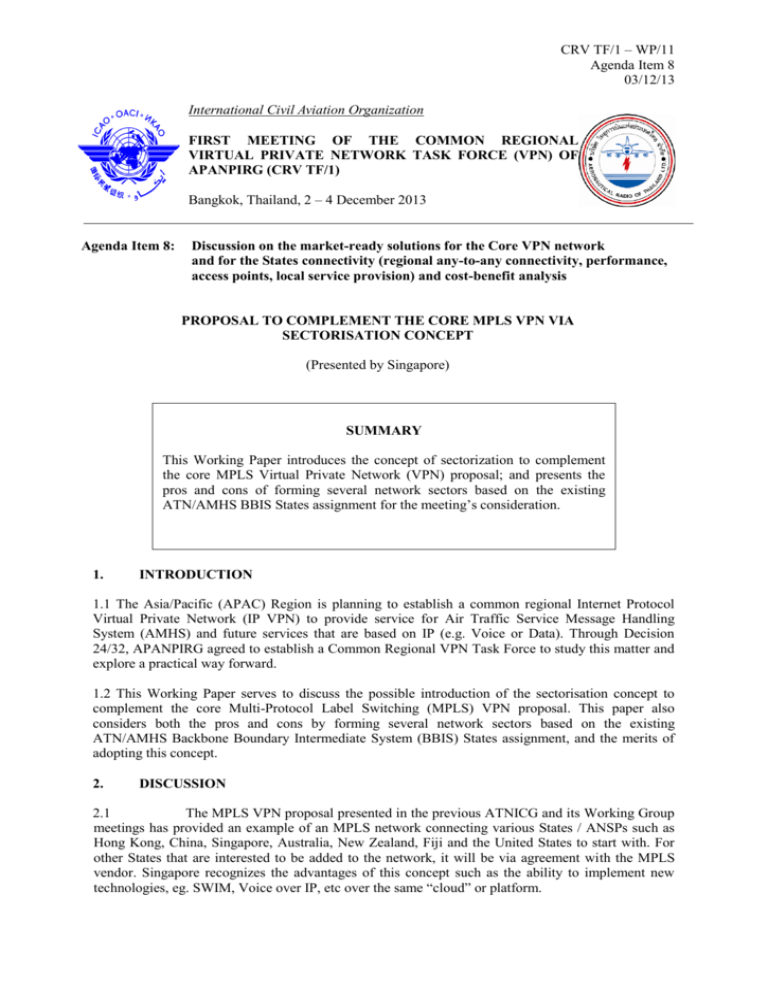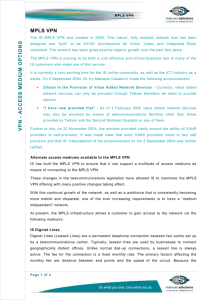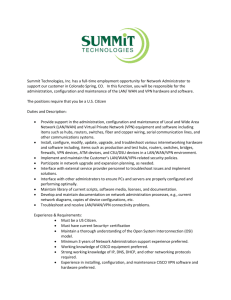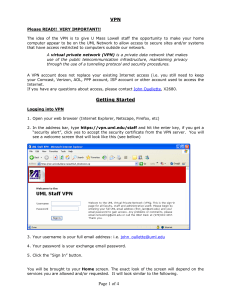WP11_SIN AI. 8 - Concept Paper for MPLS Sectorisation
advertisement

CRV TF/1 – WP/11 Agenda Item 8 03/12/13 International Civil Aviation Organization FIRST MEETING OF THE COMMON REGIONAL VIRTUAL PRIVATE NETWORK TASK FORCE (VPN) OF APANPIRG (CRV TF/1) Bangkok, Thailand, 2 – 4 December 2013 Agenda Item 8: Discussion on the market-ready solutions for the Core VPN network and for the States connectivity (regional any-to-any connectivity, performance, access points, local service provision) and cost-benefit analysis PROPOSAL TO COMPLEMENT THE CORE MPLS VPN VIA SECTORISATION CONCEPT (Presented by Singapore) SUMMARY This Working Paper introduces the concept of sectorization to complement the core MPLS Virtual Private Network (VPN) proposal; and presents the pros and cons of forming several network sectors based on the existing ATN/AMHS BBIS States assignment for the meeting’s consideration. 1. INTRODUCTION 1.1 The Asia/Pacific (APAC) Region is planning to establish a common regional Internet Protocol Virtual Private Network (IP VPN) to provide service for Air Traffic Service Message Handling System (AMHS) and future services that are based on IP (e.g. Voice or Data). Through Decision 24/32, APANPIRG agreed to establish a Common Regional VPN Task Force to study this matter and explore a practical way forward. 1.2 This Working Paper serves to discuss the possible introduction of the sectorisation concept to complement the core Multi-Protocol Label Switching (MPLS) VPN proposal. This paper also considers both the pros and cons by forming several network sectors based on the existing ATN/AMHS Backbone Boundary Intermediate System (BBIS) States assignment, and the merits of adopting this concept. 2. DISCUSSION 2.1 The MPLS VPN proposal presented in the previous ATNICG and its Working Group meetings has provided an example of an MPLS network connecting various States / ANSPs such as Hong Kong, China, Singapore, Australia, New Zealand, Fiji and the United States to start with. For other States that are interested to be added to the network, it will be via agreement with the MPLS vendor. Singapore recognizes the advantages of this concept such as the ability to implement new technologies, eg. SWIM, Voice over IP, etc over the same “cloud” or platform. CRV TF/1 – WP/11 Agenda Item 8 03/12/13 2.2 -2- However, Singapore sees a various potential problems from this concept. Potential bottleneck in this proposal as this will be a “big bang” approach for every States to be connected to the core MPLS VPN; All States have to connect to the network in order to continue existing AFTN services; All States must be agreeable to both the technical solutions and pricing; All States should be upgrading in time for the connections; Disadvantages in negotiating with the service providers in future upgrading as not all potential upgradings could be anticipated at this point of time; and This may stretch the timeline for implementation of the core VPN MPLS for the whole Asia-Pacific. 2.3 Hence, Singapore would like to propose this sectorisation concept to complement the core MPLS VPN. Our proposal is adapted from the concept of sectors similar to the existing AFTN structure in APAC region. 2.4 Singapore is proposing a sector for those States/ANSPs preferred to connect to Singapore to embark on a VPN MPLS services. These States / ANSPs are still able to enjoy the benefits of the MPLS VPN. This model is flexible enough and can also be model into States such as Hong Kong with China or Australia with New Zealand and Fiji to complement the core VPN MPLS. In fact, Singapore has already gone into the “cloud” with UK via IP VPN services from Telstra and we foresee that we would be connected with other clouds in the future such as Middle-East Region. Advantages of sectorisation 2.5 below: The advantages of implementing the sectorisation concept are as depicted in the table S/N 1. Advantages Flexibility & Scalability Core VPN network can still be deployed even with sectorisation. Easier and more flexible configuration per sector. States/ANSPs are truly having the flexibility to opt in and opt out of the network. Sector can dynamically change if there is a need, without changing the whole network requirement. 2. Risk As each sector is on a smaller scale and a sector of the bigger VPN MPLS, the risk of implementing newer technologies is lower and localized. Allowing co-existence of different technologies to allow States / ANSPs to take longer time to implement newer technology for whatever reasons. -3- CRV TF/1 – WP/11 Agenda Item 8 03/12/13 3. Bandwidth Requirement • Each sector can have smaller bandwidth; connection with other Sectors can be of higher bandwidth. 4. Security • Security management is also more manageable per sector. • To further enhance security, we can deploy firewalls at each end of the customer router before going into the VPN MPLS network. Finances • Payment model can be independent per sector requirement. • Cost division is divided into per sector, then further divided into States / ANSPs. The administrators and certain sectors may be willing to absorb part or whole implementation and upgrading costs of their sectors. States / ANSPs will then benefit from such goodwill. • Economy of scale may be achieved in certain upgrading such as software upgrades. 5. 6. Redundancy • Redundancy is achieved as States / ANSPs could have the flexibility to connect to more than one sector. 7. Testing • Testing within a sector can be simplified as it is per sector only, and connections between sectors are taken care of via Administrator of the sector. • Testing can be conducted in stages and concurrently (ie. First internal test within a sector then inter-sector tests) in each sector. Such smaller scale testing will reduce complexity and time of testing. As a result, it will reduce the risks of implementation and future upgrading. 8. Fault • Fault can be localized within each sectors and troubleshooting could be easier (ie, fault management) 9. Performance • Different required communication performance (RCP) for each sector and inter-sector can be achieved easily. • Each sector can have a lead or “hub” that will ensure connection issues are resolve with the CSP. 10. Shorter implementation time • Less coordination due to fewer parties involved at each network level. Disadvantages of Sectorisation 2.6 The biggest disadvantage of having sectors is the cost and responsibility that the BBIS that has to bear due to the number of States that are connected to the BBIS for services. Secondly, the BBIS has to bear the brunt for any security threats or attacks, defending the rest of the connections to the BBIS. CRV TF/1 – WP/11 Agenda Item 8 03/12/13 -4- Merits of Embarking on the Sectorisation 2.7 Weighing on both the pros and cons, Singapore is in the opinion that we should proceed with this sectorisation concept, at least for the initial phases. Firstly, the timeline for all the countries to go on to the core MPLS VPN will be vastly different. Hence, there will still be some countries which may still need to be on IPLC for several more years. As such, with sectorisations, the BBIS (Sector administrator) can work with the BIS to implement the sector VPN MPLS at a comfortable pace without hampering the overall core VPN implementation. Hence, countries connected to each Sector can still benefit from this sector VPN MPLS at a fraction of the cost. The countries also have a flexibility to connect to the core VPN, if they wish to do so. Thirdly, there are less parties involves at each level of the network, which will lead to faster decision making. 3. 3.1 ACTION BY THE MEETING The meeting is invited to: a) consider the proposal of the sectorisation concept for the MPLS VPN; and b) discuss any relevant matters as appropriate. ____________








